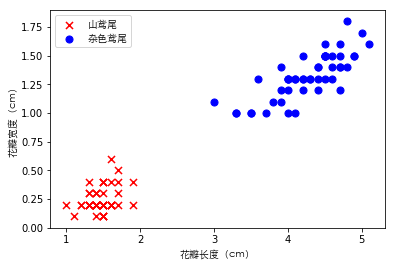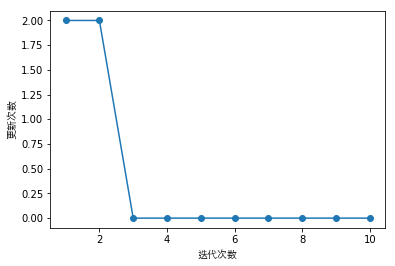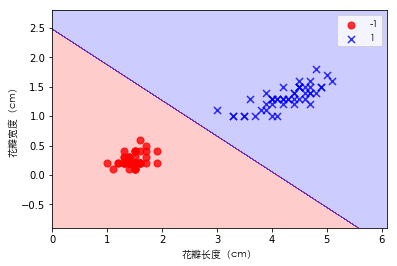| import numpy as np |
| import pandas as pd |
| import matplotlib.pyplot as plt |
| from matplotlib.colors import ListedColormap |
| from matplotlib.font_manager import FontProperties |
| |
| %matplotlib inline |
| |
| font = FontProperties(fname='/Library/Fonts/Heiti.ttc') |
| class Perceptron(): |
| """自定义感知机算法""" |
| |
| def __init__(self, learning_rate=0.01, num_iter=50, random_state=1): |
| self.learning_rate = learning_rate |
| self.num_iter = num_iter |
| self.random_state = random_state |
| |
| def fit(self, X, y): |
| """初始化并更新权重""" |
| |
| rgen = np.random.RandomState(self.random_state) |
| self.w_ = rgen.normal(loc=0.0, scale=0.01, size=1 + X.shape[1]) |
| |
| self.errors_ = [] |
| |
| |
| for _ in range(self.num_iter): |
| errors = 0 |
| for x_i, target in zip(X, y): |
| |
| update = self.learning_rate * (target - self.predict(x_i)) |
| self.w_[1:] += update * x_i |
| self.w_[0] += update |
| errors += int(update != 0.0) |
| self.errors_.append(errors) |
| |
| return self |
| |
| def predict_input(self, X): |
| """计算预测值""" |
| return np.dot(X, self.w_[1:]) + self.w_[0] |
| |
| def predict(self, X): |
| """得出sign(预测值)即分类结果""" |
| return np.where(self.predict_input(X) >= 0.0, 1, -1) |
由于获取的鸢尾花数据总共有3个类别,所以只提取前100个鸢尾花的数据得到正类(versicolor 杂色鸢尾)和负类(setosa 山尾),并分别用数字1和-1表示,并存入标记向量y,之后逻辑回归会讲如何对3个类别分类。同时由于三维以上图像不方便展示,将只提取第三列(花瓣长度)和第三列(花瓣宽度)的特征放入特征矩阵X。
| df = pd.read_csv( |
| 'http://archive.ics.uci.edu/ml/machine-learning-databases/iris/iris.data', header=None) |
| |
| |
| y = df.iloc[0:100, 4].values |
| y = np.where(y == 'Iris-versicolor', 1, -1) |
| |
| |
| X = df.iloc[0:100, [2, 3]].values |
| |
| plt.scatter(X[:50, 0], X[:50, 1], color='r', s=50, marker='x', label='山鸢尾') |
| plt.scatter(X[50:100, 0], X[50:100, 1], color='b', |
| s=50, marker='o', label='杂色鸢尾') |
| plt.xlabel('花瓣长度(cm)', fontproperties=font) |
| plt.ylabel('花瓣宽度(cm)', fontproperties=font) |
| plt.legend(prop=font) |
| plt.show() |
边界函数即的之前提及的代价函数,通过决策边界将鸢尾花数据正确的分为两个类别。
| def plot_decision_regions(X, y, classifier, resolution=0.02): |
| |
| marker_list = ['o', 'x', 's'] |
| color_list = ['r', 'b', 'g'] |
| cmap = ListedColormap(color_list[:len(np.unique(y))]) |
| |
| |
| x1_min, x1_max = X[:, 0].min() - 1, X[:, 0].max() + 1 |
| x2_min, x2_max = X[:, 1].min() - 1, X[:, 1].max() + 1 |
| t1 = np.linspace(x1_min, x1_max, 666) |
| t2 = np.linspace(x2_min, x2_max, 666) |
| |
| |
| x1, x2 = np.meshgrid(t1, t2) |
| |
| y_hat = classifier.predict(np.stack((x1.flat, x2.flat), axis=1)) |
| y_hat = y_hat.reshape(x1.shape) |
| |
| |
| plt.contourf(x1, x2, y_hat, alpha=0.2, cmap=cmap) |
| plt.xlim(x1.min(), x1.max()) |
| plt.ylim(x2.min(), x2.max()) |
| |
| for ind, clas in enumerate(np.unique(y)): |
| plt.scatter(X[y == clas, 0], X[y == clas, 1], alpha=0.8, s=50, |
| c=color_list[ind], marker=marker_list[ind], label=clas) |
可以看出模型在第6次迭代的时候就已经收敛了,即可以对数据正确分类。
| perceptron = Perceptron(learning_rate=0.1, num_iter=10) |
| perceptron.fit(X, y) |
| plt.plot(range(1, len(perceptron.errors_) + 1), perceptron.errors_, marker='o') |
| plt.xlabel('迭代次数', fontproperties=font) |
| plt.ylabel('更新次数', fontproperties=font) |
| plt.show() |
| plot_decision_regions(X, y, classifier=perceptron) |
| plt.xlabel('花瓣长度(cm)', fontproperties=font) |
| plt.ylabel('花瓣宽度(cm)', fontproperties=font) |
| plt.legend(prop=font) |
| plt.show() |


